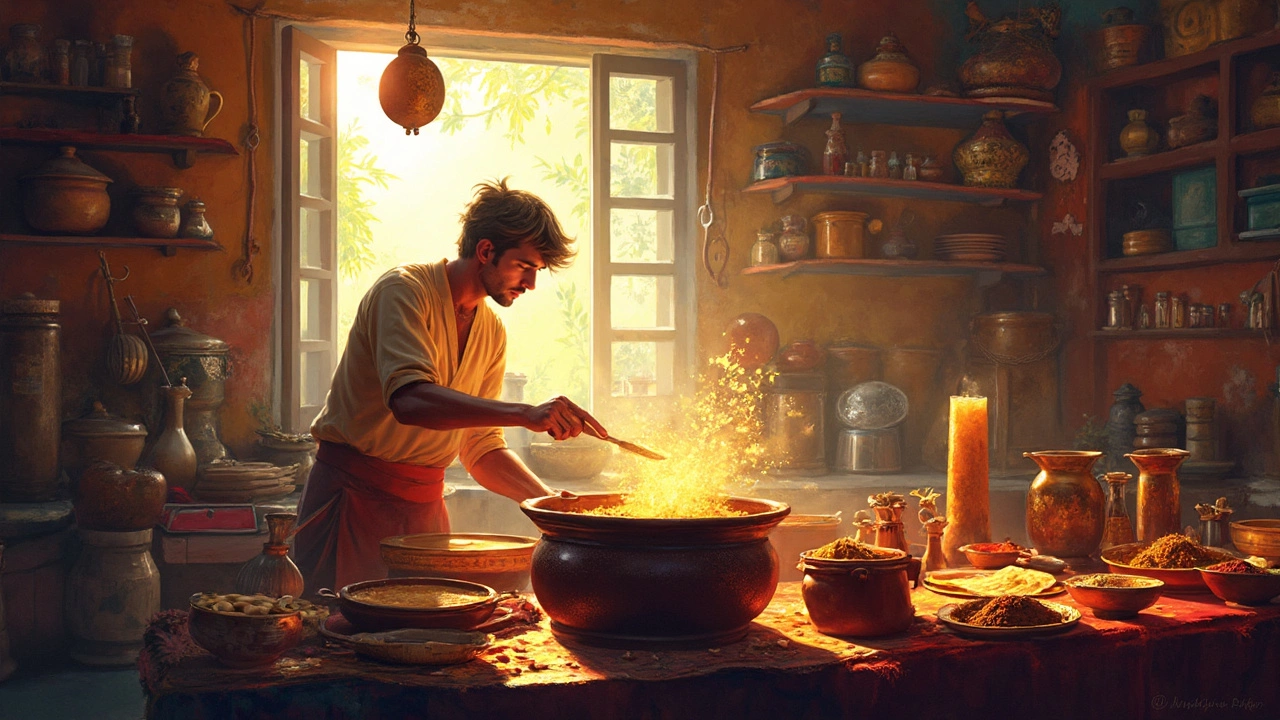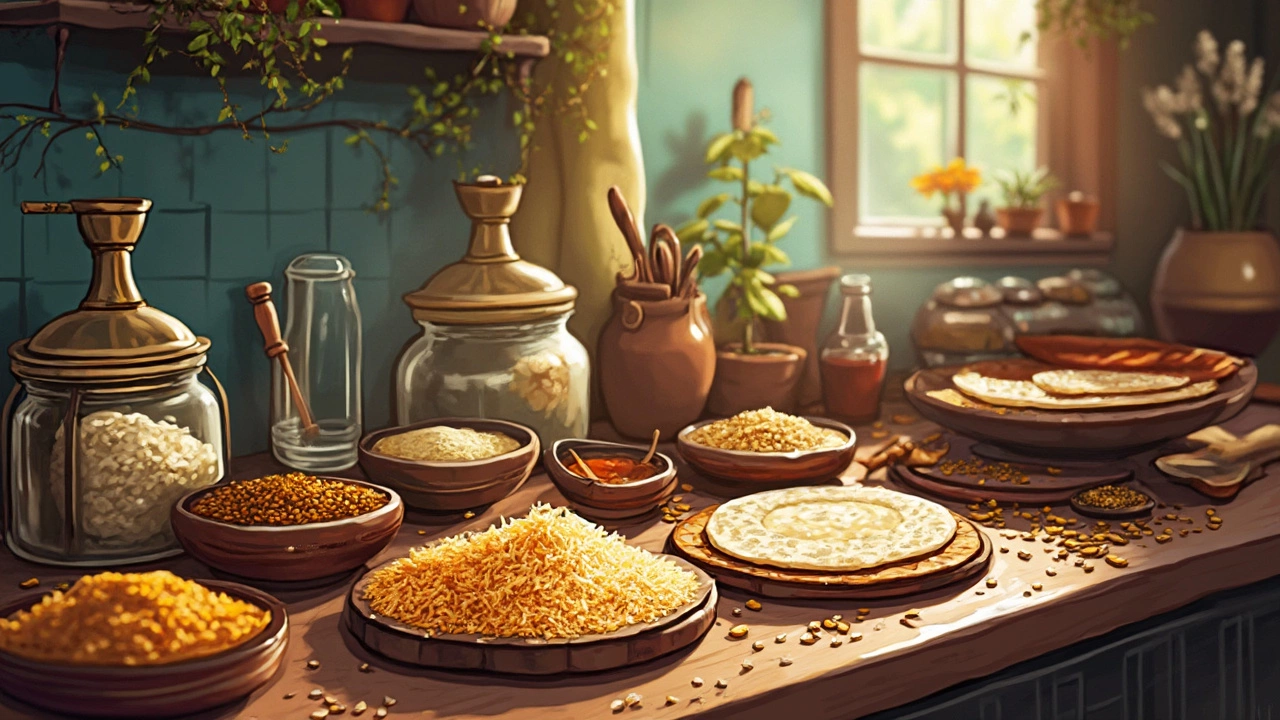Essential Tips for Speedy Dosa Batter Fermentation
 Feb, 13 2025
Feb, 13 2025
If you've ever tried to make dosa at home, you know that the key to a great dosa lies in its batter. But getting that batter to ferment just right? That's a whole other game. Sometimes it seems like the batter has a mind of its own, taking forever to rise, especially when you're eagerly waiting to flip those crispy delights.
Let's dive into some straightforward tips that can speed up dosa batter fermentation. First up, the environment. Dosa batter loves warmth, so if your kitchen is as cold as a icebox, that batter might just refuse to budge. Consider placing it in your oven with the light on, or wrapping the container in a thick cloth. It turns out, dosa batter’s pretty similar to us – it thrives in just the right cozy conditions.
Moving on to the ingredients. A little secret many miss: adding a handful of poha (flattened rice) during grinding can turbocharge your fermentation process. It’s like giving your batter a friendly nudge, asking it to get bubbly faster. Not to mention, sugar also gives things a quick start, so a small spoonful won't hurt.
- Understanding the Fermentation Process
- Key Ingredients and Their Roles
- Temperature Tips for Faster Fermentation
- The Importance of Water Quality
- Common Mistakes and How to Avoid Them
Understanding the Fermentation Process
Alright, let’s talk about what’s actually happening when you’re waiting for that dosa batter to bubble up. Fermentation is like nature’s way of giving your food that extra oomph, and it’s pretty simple once you get the hang of it.
Everything begins with those little organisms in the air called wild yeast and lactic acid bacteria. When you mix water with rice and urad dal (that’s the magic combo for dosa batter), and let it sit somewhere warm, these guys get to work. They feed on the sugars in the rice and dal and release carbon dioxide and a bit of alcohol, which makes the batter rise.
The Role of Temperature
Temperature is a game-changer here. You're aiming for that Goldilocks zone of warmth—not too hot, not too cold. If it's cold, the fermentation is going to crawl, maybe even take a couple of days. But if you crack the ambient warmth trick, it can ferment in as little as six to eight hours. Keeping it cozy is key!
Time and Patience
Fermentation is part science, part patience. It typically takes anywhere from 8 to 12 hours, depending on the climate and the season. If you’re in a colder place, give it more time, maybe even overnight. In summer, when it’s warmer, it might surprise you and be ready in less time.
Signs of a Well-Fermented Batter
- Look for bubbles on the surface. It’s a good sign your dosa batter is alive and kicking.
- The batter should have risen, usually doubling in volume.
- A slightly tangy aroma is perfect, signaling it’s ready to make dosas that taste just right.
Getting to grips with fermentation is like having a secret chat with nature. A little patience goes a long way, and once you nail it down, making dosas becomes not just a task but an art.
Key Ingredients and Their Roles
Alright, let's get to know the key players in our dosa batter – they're not just ingredients, they're team members that each have a vital role to play.
Rice and Urad Dal: The Building Blocks
Your traditional dosas need two main ingredients: rice and urad dal. They form the backbone. Now, visit any dosa enthusiast, and they'll rave about how using a 3:1 ratio of rice to urad dal works wonders. It's not just random chatter – that's the magic formula that brings the right texture.
Rice provides the starch content that gives your dosa its characteristic crispiness, while urad dal is rich in protein and forms the major source of fermentation-friendly bacteria. Oh, and it makes the batter fluffy too!
Fenugreek Seeds: The Fermentation Boosters
Ever wondered why some recipes mention a teaspoon of fenugreek seeds? They're the unsung hero here. Not only do they add a subtle flavor, but they also help kickstart the fermentation process. These tiny seeds are like a gym for your batter, pumping up the volume so you get airy, light dosas.
Flattened Rice (Poha): The Secret Ingredient
Adding a handful of poha during grinding can work wonders. This little trick ensures your dosa stays crisp. It’s amazing how a bit of poha can change the game and give your batter that extra love it needs to ferment faster.
The Role of Water
Let's not overlook water – yes, plain old water. The amount and temperature matter more than you'd think. Use cool, filtered water to grind the batter smoothly. Also, keep the batter consistency like a pancake batter. Too thick? It won't ferment well. Too runny? Say goodbye to that perfect dosa texture.
Salt: The Timing
Yes, even salt has a time and place. Add it before fermenting if you live in a warm climate, but in cooler weather, mix it in afterward. The right timing ensures you don't slow down the bacteria doing their hard work.
These ingredients aren’t just about mixing – they’re about understanding their roles and getting them to work together for that perfect, crispy dosa. Now go ahead, impress everyone with your expert knowledge!

Temperature Tips for Faster Fermentation
Temperature plays a huge role in making sure your dosa batter ferments quickly. It’s not just about being in a warm spot; it's about finding that sweet spot for the batter to do its thing efficiently. The ideal temperature for fermentation is somewhere between 25°C and 32°C (77°F and 90°F).
Ever thought about using your oven as a fermentation chamber? No, not turning it on—just the oven light! That little bulb gives off just enough warmth. Place your batter in a bowl, cover it, and let the magic happen. Works like a charm, especially during the colder months.
Winter Woes?
If winter is making fermentation slow, try a simple trick: put the container in a warm water bath. Fill a large pot with some warm water, place your tightly covered batter container inside, and replace the water as it cools. This hack maintains a stable temperature around the container.
Summer Strategies
In summer, this process is usually a walk in the park. However, don’t leave your batter in direct sunlight, as excessive heat might lead to over-fermentation, turning your batter sour. A shaded, warm corner is just right.
Also, consider the kind of vessel you're using. Metal bowls conduct heat faster, which could help maintain the optimum temperature longer than other materials.
Here's a quick temperature check:
| Temperature (°C) | Fermentation Speed |
|---|---|
| Below 20°C | Slow |
| 25-30°C | Ideal |
| Above 32°C | Too Fast (Risk of Over-fermentation) |
Using these tips, your fermentation process can become a breeze. Just find that cozy corner for your fermentation tips, and you'll be on your way to making that perfect, crispy Indian cuisine delight.
The Importance of Water Quality
Ever thought about how crucial water is for a perfect dosa? Turns out, not all water is created equal when it comes to making dosa batter. The type of water you use can be the difference between a fluffy, fermented delight and a flat disappointment.
Tap vs Filtered Water
First off, let's talk tap versus filtered water. Depending on where you live, tap water might have different mineral content, which can affect the fermentation. Hard water, loaded with minerals, can sometimes slow things down. It might be wise to switch to filtered or even bottled water if your batter isn't behaving.
Chlorine: The Batter Enemy
If your tap water has a lot of chlorine, watch out! Chlorine is great for killing bacteria in water, but not so great when you need those friendly microbes to get your batter bubbling. Boiling the water and letting it cool can be a simple fix to get rid of the chlorine before mixing it in.
- Use cold filtered water for best results.
- Avoid adding ice water as it might hinder the fermentation process.
- If unsure about your water quality, a small investment in a filter could be worth it!
Water Quantity Matters
While the quality of water is crucial, the quantity is equally important. Too much water can turn your batter runny, making fermentation slow. But too little, and you might end up with a thick paste that takes forever to rise. Aim for that sweet spot where the batter is smooth and just right. Mixing in a little water at a time can help you gauge it perfectly.
In essence, pay attention to what kind of water you use and how much of it you mix in your cooking; it could be the secret ingredient to getting those mouth-watering, picture-perfect dosas every single time!

Common Mistakes and How to Avoid Them
Even seasoned home cooks can trip up when it comes to dosa batter fermentation. Here’s a roundup of typical slip-ups and how you can sidestep them.
Using Cold Environments
The magic of fermenting dosa batter largely depends on warmth. If you’re keeping the batter in a chilly spot, the yeast action slows down dramatically. Always aim for a warm place. An easy trick? Pop the container in the oven with the light on. Just don't accidentally turn the oven on—yikes!
Ignoring Water Quality
Hard water can be a stealthy party crasher, hindering fermentation without you realizing. Use filtered or softened water to play it safe. It's a small change that makes a big difference.
Skipping the Salt
While it might seem logical to add salt after fermentation to avoid interference, a pinch at the beginning actually helps balance the fermentation. It draws out the natural sugars, giving your batter the oomph it needs.
Overloading the Batter
Pouring in too many lentils might make for dense, heavy dosas. Stick to the tried-and-tested ratio of 3:1 rice to lentils. Want softer, fluffier dosas? Consider a small boost by adding a wee bit of fenugreek seeds.
Not Grinding Enough
The texture of your batter is everything. Too coarse, and it’ll be gritty; too fine, and it might turn gummy. Aim for a smooth, pancake-batter-like consistency. A bit of practice with your blender's pulse settings goes a long way here.
By sidestepping these common pitfalls, your dosa game is sure to skyrocket, leading to perfectly fermented batter that’ll make your next dosa feast a resounding success.